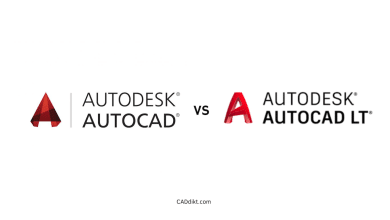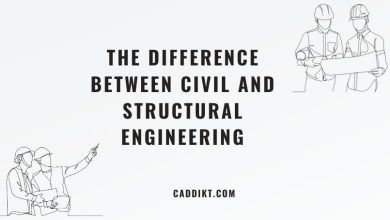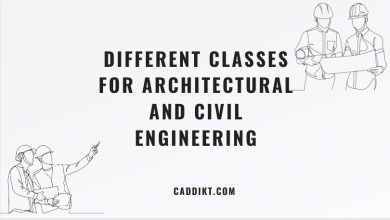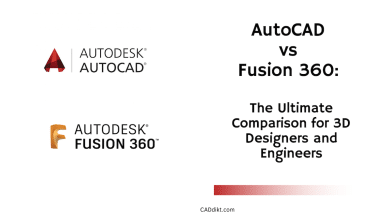In the realm of computer-aided design (CAD), AutoCAD and Autodesk Inventor are two names that frequently come up. Both developed by Autodesk, they offer a range of capabilities to professionals across various industries, from architecture and engineering to manufacturing. However, they serve different purposes and have unique strengths that make them more suitable for certain tasks and less so for others.
AutoCAD, the older of the two, is a versatile software used for creating 2D drawings and basic 3D models. In contrast, Autodesk Inventor is a more specialized tool geared towards 3D mechanical design, simulation, and product visualization. Choosing between them can often be a challenging task. This article aims to simplify this decision by providing a detailed comparison between AutoCAD and Autodesk Inventor.
Key Takeaways
- Both AutoCAD and Autodesk Inventor are powerful tools developed by Autodesk, each with its unique strengths and capabilities.
- AutoCAD is highly versatile and can handle both 2D and 3D designs, making it suitable for a wide range of industries.
- Autodesk Inventor excels in 3D mechanical design and simulation, ideal for complex product development.
- The choice between AutoCAD and Autodesk Inventor largely depends on your specific design needs and resources.
AutoCAD vs Autodesk Inventor: Understanding the Basics
AutoCAD and Autodesk Inventor are two of the most popular software programs developed by Autodesk Inc. They cater to different aspects of the design and engineering industry, and understanding their key differences is crucial in choosing the right tool for your needs. This article aims to provide a comprehensive comparison between AutoCAD and Autodesk Inventor.
AutoCAD, first introduced in 1982, is a 2D and 3D computer-aided drafting software application. It is primarily used for drafting and designing 2D drawings and basic 3D models.
Autodesk Inventor, on the other hand, is a computer-aided design application for 3D mechanical design, simulation, visualization, and documentation. Introduced in 1999, Inventor uses shape manager, Autodesk’s proprietary geometric modeling kernel.
AutoCAD: Key Features and Applications
AutoCAD is renowned for its versatility and is used in a wide range of industries, including architecture, engineering, graphic design, management, and many others. Here are some of its primary features:
- 2D Drafting and Annotations: AutoCAD provides a comprehensive toolset for creating precise 2D technical drawings.
- 3D Modeling and Visualization: With AutoCAD, you can create and render realistic 3D models.
- Customization with APIs and Add-Ons: AutoCAD supports LISP, VBA, .NET, and JavaScript APIs and offers add-ons for specific industries.
- Mobile and Web App: AutoCAD comes with a mobile app and web application, allowing you to view, edit, and create drawings in the field and on the go.
Find out more about AutoCAD’s features and applications here.
Autodesk Inventor: Key Features and Applications
Autodesk Inventor is designed to support advanced mechanical engineering designs, simulation, tooling creation, and design communication. Here are some of the main features:
- Parametric Modeling: Inventor supports parametric modeling, allowing you to create parameters as you sketch and simultaneously preview your design.
- Assembly Modeling: Inventor provides large assembly design, assembly joints, and additional tools to help you manage large assemblies.
- Drawing Creation: With Inventor, you can create clear, accurate, and detailed drawings.
- Flexible Modeling: Inventor offers free-form, direct, and parametric modeling choices.
- Simulation and Visualization: Inventor allows you to validate the form, fit, and function of your design as you work.
Learn more about Autodesk Inventor here.
AutoCAD vs Autodesk Inventor: Direct Comparisons
Comparing AutoCAD and Autodesk Inventor can seem challenging due to their diverse capabilities. However, we can make a direct comparison using several essential factors such as usability, industry-specific features, system requirements, and cost.
Usability
AutoCAD’s learning curve is slightly more gradual than Autodesk Inventor’s because it mainly deals with 2D drawings. However, for 3D models, Inventor’s user interface and logical workflow make it easier to learn and master.
| Software | Usability |
|---|---|
| AutoCAD | Easier for 2D drawings and basic 3D models |
| Autodesk Inventor | Better for complex 3D models and assemblies |
Industry-Specific Features
AutoCAD has specialized toolsets for various industries like architecture, electrical, mechanical, raster design, etc. On the other hand, Inventor is more suited to mechanical engineering, with advanced simulation and testing features for mechanical components and systems.
| Software | Industry-Specific Features |
|---|---|
| AutoCAD | Diverse toolsets for various industries |
| Autodesk Inventor | Advanced features for mechanical design and simulation |
System Requirements
Both AutoCAD and Autodesk Inventor require robust system resources for smooth operation. However, Autodesk Inventor, due to its advanced 3D modeling capabilities, generally requires a more powerful system.
| Software | System Requirements |
|---|---|
| AutoCAD | Lower system requirements |
| Autodesk Inventor | Higher system requirements |
You can find the detailed system requirements for AutoCAD and Autodesk Inventor on the official Autodesk website.
Cost
Autodesk offers various subscription plans for both AutoCAD and Autodesk Inventor. AutoCAD comes with a lower price tag, making it a more affordable option for smaller businesses or individual users. Autodesk Inventor, with its advanced capabilities, is more expensive but offers more value for larger businesses and advanced users.
| Software | Cost |
|---|---|
| AutoCAD | More affordable |
| Autodesk Inventor | More expensive, offers more advanced capabilities |
Making the Right Choice: AutoCAD or Autodesk Inventor?
Choosing between AutoCAD and Autodesk Inventor largely depends on your specific needs, the industry you’re in, and the complexity of the projects you handle.
Choose AutoCAD if:
- You primarily work with 2D drawings or basic 3D models.
- You are in an industry like architecture, civil engineering, or graphic design where detailed 2D plans and elevations are frequently required.
- You need a more affordable CAD software solution.
- You want to utilize a wide range of industry-specific toolsets.
Choose Autodesk Inventor if:
- Your work involves complex 3D modeling and assemblies.
- You are in the mechanical engineering or manufacturing industry, and need advanced simulation and testing tools.
- You need to create detailed mechanical designs.
- You have the necessary system resources and budget for a more advanced CAD software solution.
By considering these factors, you can make an informed decision on whether to choose AutoCAD or Autodesk Inventor for your design needs. Remember that both are powerful tools in their respective areas, and your choice should align with your project requirements and long-term goals.
AutoCAD vs Autodesk Inventor: User Community and Support
Both AutoCAD and Autodesk Inventor have a vast and active user community. Online forums and communities like Autodesk Knowledge Network and Autodesk Community provide a platform for users to share their experiences, ask questions, and get help from experts worldwide.
Autodesk also offers comprehensive customer support for both software, including online help, tutorials, and training courses. This ensures that users can get the most out of their software and continue to improve their skills.
| Software | User Community and Support |
|---|---|
| AutoCAD | Extensive user community and comprehensive customer support |
| Autodesk Inventor | Extensive user community and comprehensive customer support |
Learn more about the AutoCAD community and Autodesk Inventor community.
AutoCAD vs Autodesk Inventor: Software Integrations
AutoCAD and Autodesk Inventor both integrate with various other software. AutoCAD can be integrated with software like Revit, 3ds Max, and Inventor itself for different design purposes. Autodesk Inventor can be integrated with AutoCAD, Fusion 360, and Vault, providing a comprehensive solution for product development.
These integrations enable seamless workflows, allowing designers and engineers to use the best tool for each stage of their work without the need for time-consuming file conversions.
| Software | Software Integrations |
|---|---|
| AutoCAD | Integrates with Revit, 3ds Max, Inventor, and more |
| Autodesk Inventor | Integrates with AutoCAD, Fusion 360, Vault, and more |
AutoCAD vs Autodesk Inventor: Future Outlook
Both AutoCAD and Autodesk Inventor have been industry leaders for many years and continue to receive regular updates and new features from Autodesk. They are likely to remain prevalent tools in their respective fields.
AutoCAD, with its broad range of applications and industry-specific toolsets, is expected to retain its popularity. Autodesk Inventor, with its advanced 3D modeling, simulation, and testing capabilities, is likely to continue being a go-to software for mechanical engineers and product designers.
| Software | Future Outlook |
|---|---|
| AutoCAD | Continues to be a leading software in diverse industries |
| Autodesk Inventor | Expected to remain a leading software in mechanical engineering and manufacturing |
Ultimately, the choice between AutoCAD and Autodesk Inventor depends on your unique needs and circumstances. Both software offer robust features and capabilities that can help you achieve your design goals efficiently and effectively.
AutoCAD vs Autodesk Inventor: Flexibility and Compatibility
In terms of flexibility and compatibility, both AutoCAD and Autodesk Inventor score high. AutoCAD can handle both 2D and 3D designs, making it a versatile choice for a wide range of industries. Its compatibility with DWG and DXF file formats also ensures that you can easily exchange files with other users and software.
On the other hand, Autodesk Inventor provides a high degree of flexibility in 3D modeling with its parametric, direct, and freeform modeling capabilities. It also supports various file formats, including DWG, allowing for seamless data exchange with AutoCAD and other CAD software.
| Software | Flexibility and Compatibility |
|---|---|
| AutoCAD | High flexibility and compatibility with various file formats |
| Autodesk Inventor | High flexibility in 3D modeling and compatibility with various file formats |
AutoCAD vs Autodesk Inventor: Performance and Stability
When it comes to performance and stability, both AutoCAD and Autodesk Inventor are robust and reliable. AutoCAD is known for its stability and has been a staple in the design industry for decades. Its performance is also relatively stable across different system specifications.
Autodesk Inventor, being a more advanced tool, requires a high-performing system for optimal functioning. However, when provided with the right system resources, Inventor delivers high performance and stability, especially for complex 3D modeling and assembly tasks.
| Software | Performance and Stability |
|---|---|
| AutoCAD | High performance and stability across different systems |
| Autodesk Inventor | High performance and stability with appropriate system resources |
AutoCAD vs Autodesk Inventor: Innovation and Development
Autodesk is committed to the continuous development and innovation of both AutoCAD and Autodesk Inventor. This means users can expect regular updates and new features that reflect industry trends and user needs.
AutoCAD has recently introduced features like the Drawing History, allowing users to see past versions of their drawings and compare changes. On the other hand, Autodesk Inventor continues to innovate in the field of mechanical design with features like the Model-Based Definition, which allows users to fully define components and assemblies directly in 3D.
| Software | Innovation and Development |
|---|---|
| AutoCAD | Regular updates and new features in line with industry trends |
| Autodesk Inventor | Continuous innovation in mechanical design and simulation |
To sum up, both AutoCAD and Autodesk Inventor are powerful design tools developed by Autodesk, each with their unique strengths and capabilities. Your choice should depend on your specific design needs, the nature of your projects, and the resources you have at your disposal. Whether you choose AutoCAD or Autodesk Inventor, rest assured that both tools are capable of delivering high-quality design solutions.
FAQ: AutoCAD vs Autodesk Inventor
1. Is Inventor better than AutoCAD?
Whether Autodesk Inventor is “better” than AutoCAD depends on your specific needs and projects. Autodesk Inventor is a 3D modeling software primarily used for mechanical design, simulation, and visualization. If your work requires designing and simulating complex mechanical parts and assemblies, then Inventor may be a more suitable choice.
On the other hand, AutoCAD is a versatile software that excels in creating precise 2D drawings and basic 3D models. It is widely used across many industries like architecture, civil engineering, and graphic design. If your work mainly involves 2D drafting or you need a more affordable and less resource-intensive software, AutoCAD could be better for you.
In summary, neither software is inherently “better” than the other. The best tool for you depends on your specific needs, the nature of your projects, your budget, and system resources.
2. What is the difference between Autodesk and AutoCAD?
Autodesk is the company that develops several software products, and AutoCAD is one of these products. Autodesk Inc., founded in 1982, is a multinational software corporation that specializes in making software services for architecture, engineering, construction, manufacturing, media, education, and entertainment industries.
AutoCAD, developed and sold by Autodesk, is a computer-aided design (CAD) software used by architects, engineers, and construction professionals to create precise 2D and 3D drawings. It was the first significant CAD program on the personal computer and is the flagship product of Autodesk.
In short, Autodesk is the company, while AutoCAD is a software product created by Autodesk. They are related but serve different roles: one is a corporate entity, and the other is a software tool used in various industries.
3. Is Inventor compatible with AutoCAD?
Yes, Autodesk Inventor is compatible with AutoCAD in several ways. Inventor can import and export AutoCAD files in DWG format, allowing for seamless data exchange between the two software. This means you can design a part in Inventor, export it to AutoCAD for further detailing, and then bring it back into Inventor.
Also, Inventor has an “AutoCAD-like” interface option, which can make AutoCAD users more comfortable when transitioning to Inventor. This feature harmonizes the user experience between the two platforms.
Lastly, Autodesk provides an option for interoperability between Inventor and AutoCAD through the “AnyCAD” feature. AnyCAD allows Inventor users to maintain an associative link to native AutoCAD data, facilitating real-time collaboration.
4. What is Autodesk Inventor good for?
Autodesk Inventor is primarily used for 3D mechanical design, design communication, tool creation, and product simulation. It excels in creating detailed and accurate 3D models of parts and assemblies, making it a popular tool in the manufacturing industry.
Inventor’s parametric modeling capability is another strong suit. It allows designers to maintain relationships between parts and assemblies, change parameters, and automatically update the design accordingly. This feature streamlines the design process and boosts productivity.
Inventor also stands out in its ability to perform complex simulations. It allows engineers to test and validate their designs within the software environment, reducing the need for physical prototypes. In turn, this capability can significantly speed up the product development process and reduce costs.
5. Do engineers use AutoCAD or Inventor?
Both AutoCAD and Inventor are used by engineers, but the specific type of engineering work often determines which software is preferred. AutoCAD is widely used by civil engineers for creating architectural plans and blueprints. It’s also popular in the electrical engineering field for designing circuit layouts.
On the other hand, mechanical engineers often prefer Inventor because of its advanced 3D modeling capabilities and specialized tools for designing mechanical parts and assemblies. Inventor also provides robust simulation tools that allow engineers to test their designs under real-world conditions, a feature highly beneficial for product development.
However, it’s important to note that the use of AutoCAD or Inventor is not strictly tied to a specific engineering discipline. Some mechanical engineers may find AutoCAD sufficient for their needs, while some civil engineers might use Inventor for certain projects. The choice of software depends on the specific requirements of each project and personal preferences.
6. Can you edit DWG in Inventor?
Yes, Autodesk Inventor can import and edit DWG files, which is the native file format for AutoCAD. This capability facilitates a seamless exchange of data between the two software. Once a DWG file is imported into Inventor, you can manipulate the 2D data or use it as a basis for creating 3D models.
Inventor also supports “DWG Underlays,” allowing you to insert AutoCAD DWG files into an Inventor part file as a sketch symbol. You can then use these 2D sketches as a reference for creating 3D models.
Furthermore, Inventor maintains an associative link to the original DWG file. This means that any changes made to the DWG file in AutoCAD will automatically update in Inventor, ensuring data consistency across the two platforms.
7. Is Inventor CAD free?
Autodesk Inventor is not free, but Autodesk offers a free trial of Inventor for you to test the software before committing to a purchase. The free trial typically lasts for 30 days and provides full access to all features and capabilities of the software.
For students, educators, and academic institutions, Autodesk provides a free educational version of Inventor. This version is fully functional and can be used for learning and teaching purposes. However, designs created using the educational version are not licensed for commercial use.
Autodesk offers various subscription plans for Inventor, including monthly, yearly, and multi-year options. Pricing details can be found on the official Autodesk website.
8. Is Inventor good for 3D modeling?
Yes, Autodesk Inventor is an excellent tool for 3D modeling, especially for mechanical design. It offers a comprehensive suite of tools for creating and editing 3D models, including parametric and direct modeling, freeform, and surface modeling.
Inventor’s parametric modeling capability is particularly noteworthy. It allows designers to define relationships between features and parts, enabling changes to be automatically propagated throughout the design. This feature significantly streamlines the design process and increases efficiency.
Furthermore, Inventor provides advanced assembly modeling capabilities. Designers can create complex assemblies with thousands of parts, manage assembly constraints, and perform interference checks. With Inventor, you can accurately represent and visualize how different parts will fit and work together in a final product.
9. How do I convert Autodesk Inventor to AutoCAD?
To convert an Autodesk Inventor file to AutoCAD, you can use the “Export” function in Inventor. Here are the steps:
- Open your Inventor file.
- Click on “File” in the top left corner.
- Select “Export” from the dropdown menu, then click on “CAD Format.”
- In the Save As dialog box, choose “AutoCAD DWG Files” in the Save as type dropdown menu.
- Choose the location to save your file, provide a name, and click “Save.”
This process will convert your Inventor file into a DWG file, which you can then open and edit in AutoCAD.
Converting a 3D AutoCAD model to Inventor involves importing the AutoCAD file into Inventor and then manipulating the data as necessary. Here are the steps:
- Open Autodesk Inventor.
- Click on “Open” in the top left corner.
- Navigate to your AutoCAD file, select it, and click “Open.”
- In the Import dialog box, ensure that the file type is set to AutoCAD DWG, then click “OK.”
This will import your 3D AutoCAD model into Inventor, where you can then work on it as you would with any other Inventor model. Remember that while the import process is usually straightforward, the complexity of the AutoCAD model may affect how well it translates into Inventor.
11. What CAD format does Autodesk Inventor use?
Autodesk Inventor uses its proprietary file format with the extensions .ipt for part files, .iam for assembly files, and .idw or .dwg for drawing files. These file formats are designed to take full advantage of Inventor’s advanced 3D modeling capabilities.
However, Inventor also supports a wide range of other file formats for import and export. This includes common CAD formats such as DWG (AutoCAD), STEP, IGES, and STL, among others. This ensures that Inventor users can easily exchange data with users of other CAD software.
The specific format you should use depends on your needs. For example, if you’re collaborating with someone using a different CAD software, you might want to use a neutral file format like STEP. If you’re preparing a model for 3D printing, you would likely use STL.
Conclusion
AutoCAD and Autodesk Inventor are both powerful CAD tools, each offering its unique advantages. AutoCAD is renowned for its versatility, making it the go-to software for professionals needing to create precise 2D and basic 3D designs. Conversely, Autodesk Inventor is preferred for its advanced 3D modeling capabilities, especially for mechanical design and simulation.
Making a choice between the two will largely depend on your specific needs, the nature of your projects, and the resources at your disposal. No matter your choice, rest assured that both AutoCAD and Autodesk Inventor are capable of delivering high-quality design solutions. It’s a matter of picking the right tool for the right job. Understanding the strengths and limitations of each will help you make an informed decision that best suits your workflow.








